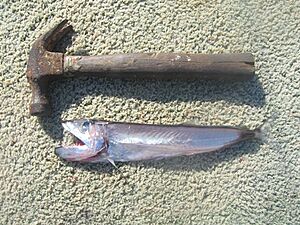Hammerjaw facts for kids
Quick facts for kids Hammerjaw |
|
|---|---|
 |
|
| Conservation status | |
| Scientific classification |
The hammerjaw, also known as Omosudis lowii, is a small, fascinating deep-sea fish. It lives deep in the ocean, in tropical and temperate waters all around the world. You can find it as deep as 4,000 meters (about 13,000 feet)! It's the only fish in its special family, Omosudidae. The name "Omosudidae" comes from Greek and Latin words that mean "shoulder" and "fish" or "stake."
What Does a Hammerjaw Look Like?
The hammerjaw has a very large head. Its most noticeable feature is a huge lower jaw that looks like it's been cut short. This jaw has a dark, almost black tip, like a "chin." Inside its lower jaw, you'll find at least one pair of very large, clear, and sharp teeth, like tiny daggers! It also has 1 to 4 pairs of slightly smaller teeth on its palate (the roof of its mouth).
Its body is quite flat from side to side. It doesn't have any scales. Instead, it's covered in shiny, silvery-gray stuff called guanine, which gives it an iridescent (rainbow-like) shimmer. You might see its dark inner lining (called the peritoneum) showing through in some spots. The top of its body is a dark smoky gray.
The body gets much thinner towards its tail. The thin part connecting the body to the tail is called the caudal peduncle. This part is a smoky black color, even darker than the rest of the body and tail. The tail itself is deeply forked, like a "V" shape.
All of the hammerjaw's fins are soft and don't have any sharp spines. Its pectoral fins (on its sides, like arms) and pelvic fins (on its belly) are quite small. It has a single dorsal fin (on its back) and an anal fin (on its belly, near the tail). These two fins are about the same size. The anal fin starts just behind the dorsal fin.
The hammerjaw also has a clear lateral line (a sensory organ that helps fish detect movement in water). It has 20 to 25 gill rakers, which help it filter food. Like other fish in its group, it has a small, fleshy fin called an adipose fin. The biggest hammerjaw ever recorded was about 23 centimeters (9 inches) long, not counting its tail.
Hammerjaw Life and Habits
We don't know a lot about the hammerjaw's life. It lives in the middle and deepest parts of the pelagic zone (the open ocean), down to 4,000 meters. Scientists rarely catch many of them at once. Because they are caught so rarely and have a sleek body shape, scientists believe hammerjaws are very fast swimmers. They are probably good at avoiding fishing nets!
Hammerjaws seem to spawn (release eggs) all year round. Like many other deep-sea fish, they are hermaphrodites. This means each fish has both male and female reproductive organs.
Hammerjaws are carnivores, meaning they eat other animals. They feed on squid and other pelagic fish (fish that live in the open ocean). In turn, bigger fish like lancetfish and tuna are known to eat hammerjaws.



